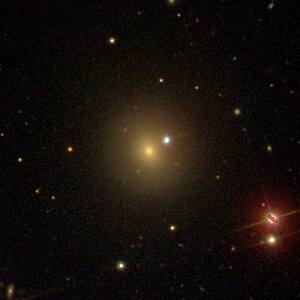NGC 2800
| Galaxie NGC 2800 | |
|---|---|
 | |
| SDSS-Aufnahme | |
| AladinLite | |
| Sternbild | Krebs |
| Position Äquinoktium: J2000.0, Epoche: J2000.0 | |
| Rektaszension | 09h 18m 35,2s[1] |
| Deklination | +52° 30′ 52″[1] |
| Erscheinungsbild | |
| Morphologischer Typ | E[1] |
| Helligkeit (visuell) | 12,8 mag[2] |
| Helligkeit (B-Band) | 13,8 mag[2] |
| Winkelausdehnung | 1,4′ × 0,9′[2] |
| Positionswinkel | 15°[2] |
| Flächenhelligkeit | 13,1 mag/arcmin²[2] |
| Physikalische Daten | |
| Rotverschiebung | 0.025424 ± 0.000103[1] |
| Radialgeschwindigkeit | (7622 ± 31) km/s[1] |
| Hubbledistanz H0 = 73 km/(s • Mpc) | (342 ± 24) · 106 Lj (105,0 ± 7,4) Mpc [1] |
| Durchmesser | 140.000 Lj[3] |
| Geschichte | |
| Entdeckung | William Herschel |
| Entdeckungsdatum | 17. März 1790 |
| Katalogbezeichnungen | |
| NGC 2800 • UGC 4920 • PGC 26302 • MCG +09-15-117 • 2MASX J09183516+5230524 • GC 1789 • H III 832 • h 574 • | |
NGC 2800 ist eine elliptische Galaxie vom Hubble-Typ E im Sternbild Großer Bär am Nordsternhimmel, die schätzungsweise 342 Millionen Lichtjahre von der Milchstraße entfernt ist.
Das Objekt wurde am 17. März 1790 von dem deutsch-britischen Astronomen William Herschel mit einem 48-cm-Teleskop entdeckt.[4]
Weblinks
Einzelnachweise
Auf dieser Seite verwendete Medien
Autor/Urheber: Sloan Digital Sky Survey, Lizenz: CC BY 4.0

Angle of view: 4' × 4' (0.3" per pixel), north is up.
Details on the image processing pipeline: https://www.sdss.org/dr14/imaging/jpg-images-on-skyserver/